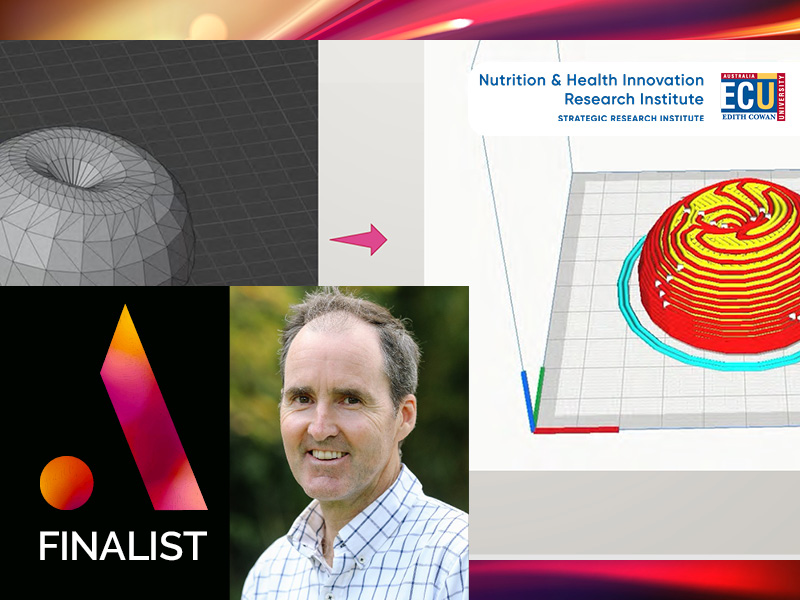Each year in Australia, enough food to fill the MCG nine times over goes to waste.
This is equal to 7.6 million tonnes of food wasted, costing the economy $36.6 billion annually.
And every year 2.4 billion kilograms of food never leaves the farm at all, accounting for nearly a third of all produce, and this is often due to small, aesthetic imperfections.
A group of researchers at Western Australia’s Edith Cowan University (ECU) is taking a novel approach to try to combat this huge financial, environmental and health issue.

The team from the Nutrition and Health Innovation Research Institute at ECU is leading the way in the use of 3D-food printing technology, using these innovations to transform imperfect fruit and vegetables rejected for sale into more appetising and nutritious options for specific groups, such as those in aged care.
Led by Postdoctoral Research Fellow Liezhou Zhong, who established the university’s Future Foods and Digital Gastronomy Lab, the team has been working on novel 3D-printed food products that meet nutritional and health needs.
The plan is to use 3D printing and freeze-drying technology to “upcycle” aesthetically imperfect but entirely edible fruit and vegetables — currently being treated as farm waste — into affordable 3D printable food products.
This process can help to make imperfect food more appealing to individuals on texture-modified diets, such as residents in aged care homes around the country.
The ECU’s Nutrition and Health Innovation Research Institute is a finalist in the InnovationAus 2024 Awards for Excellence in the Food and Agritech category. You can secure your tickets to the black-tie gala event here.
The process being pioneered by the research team involves fruit and vegetables being chopped, freeze-dried and then pureed in order to create “inks” which can then be 3D-printed into a range of new designs.
This process can either make the produce look more like the ideal version of the real thing, or can resemble fun objects to make them more appealing for children, for example.
“We can use these ugly fruits and vegetables because the produce we’re using to create the inks for our printers is pureed, so it doesn’t matter what it looks like,” Dr Zhong said.
“We’re working with chefs, farmers and producers to ensure food that would normally go to waste can still find a use and importantly tastes and looks good.”
The research team at ECU has received significant government funding, and the lab was first established with seed funding of more than $200,000 from the Western Australian government and the university.
Zhong was also awarded the Emerging Leaders Fellowship in 2022 worth nearly $400,000, and two National Health and Medical Research Council Ideas Grants in 2023, landing more than $2.1 million in total.
A key use case of this technology is in the aged care space, where it will aim to help residents achieve their recommended daily fruit and vegetables intake. The use of 3D printing can help to improve the appeal of this product, enhance its flavour and assist those who may have swallowing difficulties.
The Royal Commission into Aged Care Quality and Safety revealed shocking malnutrition in aged care settings, with little attention on the food being provided. This suboptimal food is still rife in aged care, and the ECU team is looking to address this through providing appealing, flavourful, nutrient-dense 3D-printed food options for residents.
The technology being developed is expected to also have applications for a number of other groups, including those with dementia, Huntington’s disease, multiple sclerosis and motor neuron disease, among others.
The team at the Future Foods and Digital Gastronomy Lab include researchers and chiefs, and its facilities include a commercial kitchen space, pilot-scale freeze dryer and food processor, 3D food printers, moisture analyser, water activity metre and other specialised equipment.
Looking for brand exposure in front of Australia’s tech ecosystem? Purchase a table of 10 for the InnovationAus 2024 Awards for Excellence and have your logo displayed on screens across the venue and in the event programme as a table sponsor.
The InnovationAus 2024 Awards for Excellence are supported by: Australian Computer Society, Investment NSW, Department of Industry, Science and Resources, Technology Council of Australia, TechnologyOne, National Artificial Intelligence Centre, CSIRO’s ON Innovation Program, Reason Group, Q-CTRL, University of New South Wales, and IP Australia.
Protecting your great ideas with intellectual property (IP) rights can lead to lasting benefits for your growing business. IP refers to creations of the mind, such as a brand, logo, invention, design or artistic work. Head to the IP Australia website to find out more about IP, and how it might help your business.
Do you know more? Contact James Riley via Email.
